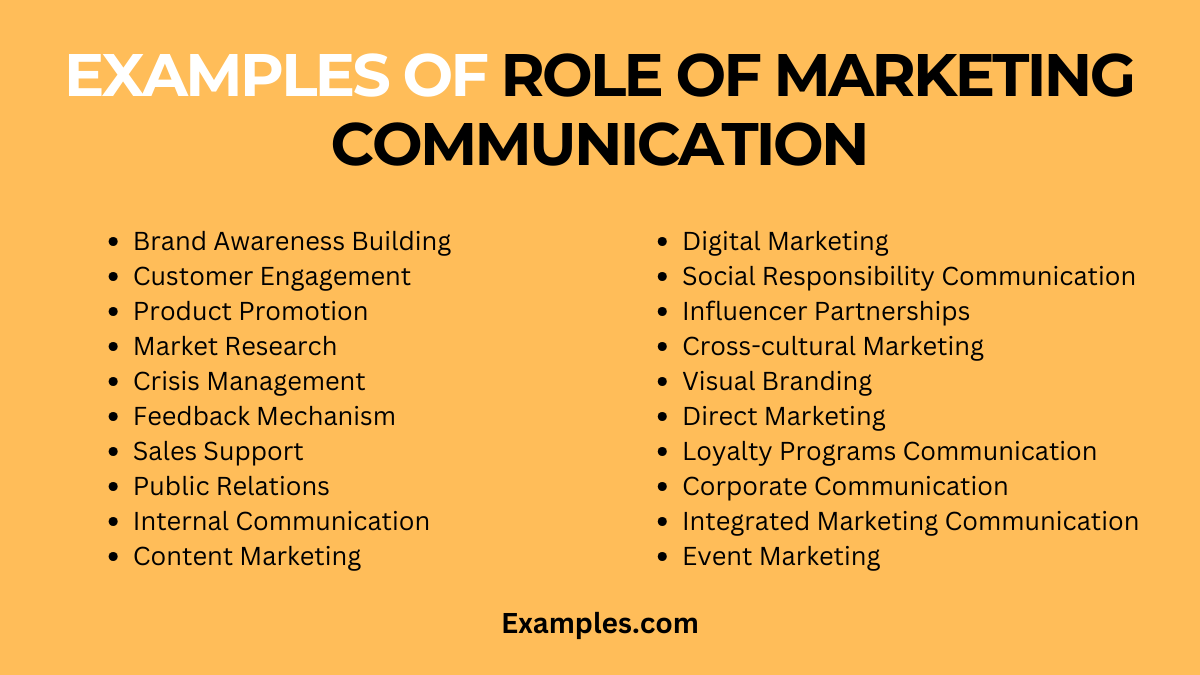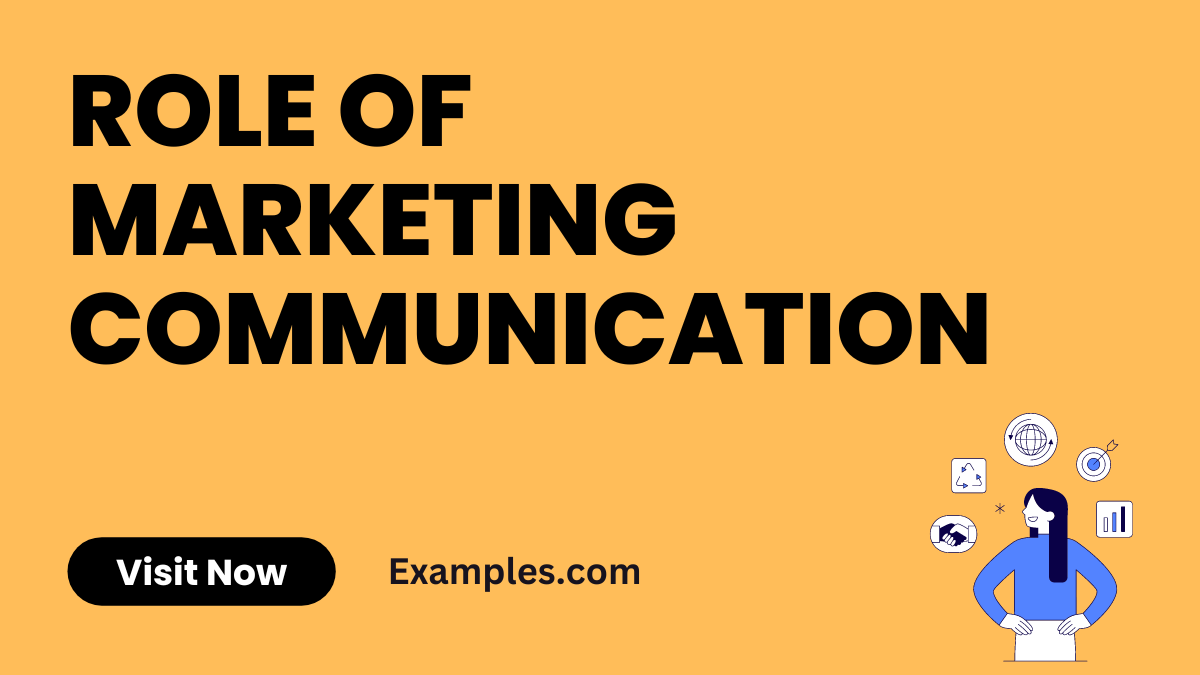19+ Role of Marketing Communication Examples
Understanding the role of marketing communication is vital for any business looking to establish a strong market presence. It involves a strategic blend of advertising, public relations, and direct marketing to effectively convey a brand’s message. This guide, rich with marketing communication examples, will delve into various aspects of marketing communication, highlighting its significance in building brand awareness, engaging customers, and driving sales. We’ll explore real-life examples to illustrate how effective communication strategies can lead to tangible business results.
20 Role of Marketing Communication Examples

- Brand Awareness Building: Enhances visibility and recognition of the brand.
Example: Apple’s iconic product launch events significantly boost brand awareness. - Customer Engagement: Strengthens relationships with customers through interactive communication.
Example: Starbucks’ social media campaigns engage customers with personalized content. - Product Promotion: Communicates the benefits and features of products or services.
Example: Nike’s inspiring ad campaigns effectively showcase their products’ unique features. - Market Research: Helps in understanding consumer needs and preferences.
Example: Google’s use of search data to tailor marketing strategies. - Crisis Management: Manages brand reputation during challenging times.
Example: Johnson & Johnson’s transparent communication during product recalls. - Feedback Mechanism: Allows companies to receive and act on customer feedback.
Example: Amazon’s review system provides valuable customer insights. - Sales Support: Assists in driving sales through persuasive messaging.
Example: Coca-Cola’s holiday campaigns typically boost sales figures. - Public Relations: Builds and maintains a positive public image.
Example: Tesla’s media relations strategy enhances its brand image. - Internal Communication: Keeps employees informed and aligned with the brand’s goals.
Example: Google’s internal newsletters keep staff updated and engaged. - Content Marketing: Creates and shares valuable content to attract customers.
Example: HubSpot’s informative blog attracts and educates potential clients. - Event Marketing: Promotes brand presence through events and sponsorships.
Example: Red Bull’s sponsored extreme sports events enhance brand visibility. - Digital Marketing: Uses online platforms for brand promotion.
Example: Netflix’s use of social media for promoting new releases. - Social Responsibility Communication: Showcases the brand’s commitment to social causes.
Example: Patagonia’s environmental campaigns resonate with eco-conscious consumers. - Influencer Partnerships: Leverages influencers to reach target audiences.
Example: Fashion brands collaborating with Instagram influencers to reach younger demographics. - Cross-cultural Marketing: Adapts communication to suit diverse audiences.
Example: McDonald’s tailoring its menu and marketing for different countries. - Visual Branding: Uses design elements to communicate brand identity.
Example: Coca-Cola’s red and white branding is instantly recognizable worldwide. - Direct Marketing: Communicates directly with consumers to elicit a response.
Example: Email newsletters from e-commerce sites offering personalized discounts. - Loyalty Programs Communication: Encourages repeat business through rewards.
Example: Sephora’s Beauty Insider program fosters customer loyalty. - Corporate Communication: Conveys a company’s corporate identity and values.
Example: Microsoft’s communication focuses on innovation and reliability. - Integrated Marketing Communication: Ensures consistency across all communication channels.
Example: Disney’s seamless branding across movies, parks, and merchandise.
Each of these roles illustrates how marketing communication is an indispensable tool in shaping the relationship between a brand and its audience, ultimately contributing to the brand’s success and longevity.
Role of Marketing Communication in Business
- Building Brand Identity: Marketing communication shapes a business’s brand identity, creating a unique image in the market. Example: Apple’s consistent messaging emphasizes innovation and quality, creating a distinct brand identity.
- Enhancing Customer Engagement: Engaging content keeps customers interested and involved with the brand. Example: Coca-Cola’s interactive social media campaigns increase customer engagement.
- Generating Leads and Sales: Strategic marketing communication drives sales by attracting and converting potential customers. Example: Amazon’s targeted email marketing campaigns lead to increased sales.
- Facilitating Market Positioning: Communication helps position the business in the marketplace. Example: Tesla’s communication strategy positions it as a leader in sustainable automotive technology.
- Supporting Product Launches: Effective communication is crucial for successful product introductions. Example: Samsung’s global campaigns for new smartphone launches.
- Cultivating Customer Loyalty: Regular and relevant communication fosters long-term customer relationships. Example: Starbucks Rewards program keeps customers loyal through personalized offers.
- Managing Brand Reputation: Proactive communication helps in shaping and maintaining a positive brand reputation. Example: Johnson & Johnson’s transparent communication during product recalls.
Role of Marketing Communication in Society
- Influencing Consumer Behavior: Marketing communication can significantly influence consumer choices and habits. Example: Anti-smoking campaigns have effectively reduced smoking rates.
- Educating the Public: Informative campaigns educate society on various issues. Example: Environmental campaigns by NGOs raise awareness about sustainability.
- Supporting Social Causes: Brands often use their communication channels to support social causes. Example: Dove’s campaigns promoting real beauty standards and body positivity.
- Driving Cultural Trends: Marketing communication often sets and drives cultural trends. Example: Nike’s “Just Do It” campaign influencing fitness culture.
- Facilitating Public Health Messages: During crises, marketing communication can spread vital public health information. Example: Government COVID-19 safety campaigns.
- Promoting Ethical Consumerism: Communication campaigns can encourage ethical buying decisions. Example: Patagonia’s focus on environmental conservation in its marketing.
- Shaping Public Opinion: Marketing communication has the power to shape societal views on various topics. Example: Campaigns for renewable energy influencing public opinion on environmental issues.
Role of Marketing Communication in Service Marketing
- Highlighting Service Benefits: Clearly communicates the benefits of services offered. Example: FedEx’s campaigns emphasizing reliability and speed in delivery services.
- Building Customer Trust: Transparent communication builds trust in service-oriented businesses. Example: Financial institutions using clear communication to build trust with clients.
- Enhancing Service Visibility: Makes potential customers aware of available services. Example: Airbnb’s marketing strategies highlighting unique accommodation experiences.
- Creating Service Differentiation: Differentiates a service from competitors. Example: Uber’s communication focusing on convenience and affordability.
- Facilitating Customer Engagement: Engages customers through interactive service marketing. Example: Fitness apps using personalized communication to keep users engaged.
- Managing Customer Expectations: Sets realistic expectations about the service. Example: Airlines communicating transparently about flight schedules and delays.
- Supporting Customer Relationships: Builds and maintains long-term customer relationships. Example: Insurance companies using personalized communication to nurture client relationships.
Marketing communication plays a pivotal role in shaping business success, influencing societal norms, and enhancing service marketing. By understanding its multifaceted impact, businesses can craft messages that not only promote their products and services but also contribute positively to society and customer relationships. This guide provides insights and tips on effectively harnessing the power of marketing communication for diverse objectives.



